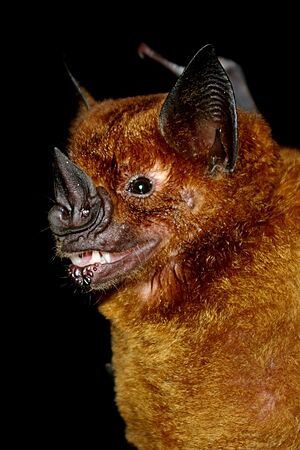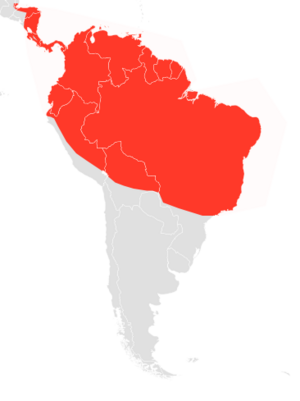Greater spear-nosed bat facts for kids
Quick facts for kids Greater spear-nosed bat |
|
|---|---|
 |
|
| Conservation status | |
| Scientific classification | |
| Genus: |
Phyllostomus
|
| Species: |
hastatus
|
 |
|
| Greater spear-nosed bat range | |
The greater spear-nosed bat (Phyllostomus hastatus) is a large bat from South and Central America. It belongs to the Phyllostomidae family. These bats are omnivorous, meaning they eat both plants and animals.
Contents
Where Do These Bats Live?
Greater spear-nosed bats live in warm, tropical areas of the Americas. You can find them from Guatemala and Belize in the north, all the way south to Peru, Bolivia, Paraguay, northern Argentina, and Brazil. They also live on islands like Trinidad and Tobago and Margarita Island in Venezuela.
These bats are often found near streams and other water sources. However, they can also live in drier places. They make their homes in both open areas and thick forests.
What Do They Look Like?
The greater spear-nosed bat is quite big for a bat. Its body is about 10 to 13 centimeters (4 to 5 inches) long. Its wings can spread out to about 45.5 centimeters (18 inches) wide. Even though it's large, it's very light, weighing around 81 grams (2.9 ounces).
Its fur is long and thick, usually dark brown. The fur on its belly might have a slight orange color. It has a special nose that looks like a spearhead, which is how it got its name. Its ears are set far apart and are smaller than those of some other bats in its family. The lower lip has a clear V-shaped groove and many small bumps. Both male and female bats have a throat sac near their chest. The male's sac is much larger than the female's.
What Do They Eat?
The greater spear-nosed bat is an omnivorous animal. This means it eats a mix of different foods. It mostly feeds on fruits, seeds, pollen, nectar, and insects. Sometimes, it might eat small animals like mice, birds, or even other bats. However, these small animals are only a tiny part of its diet.
These bats have an amazing sense of smell. They can find hidden pieces of fruit, like bananas, even when they are buried under leaves on the forest floor. They also enjoy fruits from plants like Cecropia, Piper, Solanum, and Vismia.
How Do They Use Echolocation?
Greater spear-nosed bats use a special skill called echolocation to find their way around and hunt. They make loud calls that spread out widely. By listening to the echoes that bounce back, they can figure out how far away objects are. They are so good at this that they can tell the difference between echoes that are only 20 microseconds apart. This means they can sense tiny differences in distance, as small as 4 millimeters (0.16 inches)!
How Do They Live in Groups?
Greater spear-nosed bats live together in large groups. These groups can have anywhere from ten to a hundred bats. They like to roost, or rest, in places like caves, hollow trees, termite mounds, and even under thatched roofs.
Within a large group, there are often smaller subgroups. One strong male bat, called the dominant male, leads a group of up to thirty females. On average, a dominant male will have about eighteen females in his group. This dominant male can stay in charge of his group for many years. The other males and young females form their own separate "bachelor groups" to complete the colony.
Studies have shown that females in a colony often form stable friendships, even if they are not related. These female groups work together. They will protect the young bats of their own group. However, they might act aggressively towards young bats from other groups living in the same cave.
Bats in a feeding group often help each other find food. If one bat finds a good food source, it will let the others know where it is. This cooperation helps the whole group find enough to eat. Dominant males usually have feeding spots closer to their roost. Other males might have to fly as far as 9 kilometers (5.6 miles) to find food.
Life Cycle and Reproduction
The way greater spear-nosed bats reproduce can be a bit different depending on where they live. Generally, they have young once a year. However, some females have been found with young at different times, suggesting they might reproduce more often. They usually give birth to only one baby bat at a time. Their reproduction rate is quite low.
Here is a general idea of their reproduction cycle:
- February to April: Females are pregnant.
- May to mid-July: Mothers are nursing their babies.
- Mid-July to late October: This is a resting period for reproduction.
- Late October to February: Females are ready to mate again.
Scientists think that females might eat more small animals during the time they are nursing their babies. This could be to get extra protein needed for milk production.
Why Are These Bats Important?
Greater spear-nosed bats are helpful to humans in many ways, but they can also cause some problems. They eat insects and other pests that could damage crops. They also help pollinate many plants, which means they help plants make seeds and fruits. However, they do sometimes eat crops like bananas.
These bats are not currently endangered. But people are concerned about their homes being destroyed, which could harm their populations in the future.


